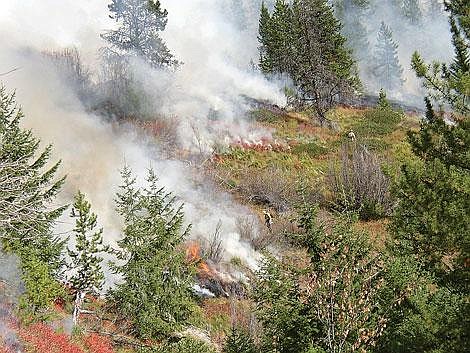Forest Service looks for public comment on new project
Residents on the west end of Mineral County will have some peace of mind when it comes to wildfires in the coming years.
The DeBaugan Fuels Reduction Project Draft Environmental Impact Statement was released to the public Feb. 8.
"About two or three years ago, a group of concerned citizens came in to visit us about worsening fuel conditions near their communities," said Superior District Ranger Sharon Sweeney.
Sweeney said that since then, the Lolo National Forest has been working with environmentalists and residents of Cabin City, DeBorgia, Haugan and Saltese to come up with solutions to wildfires in the wildland urban interface of those areas.
The EIS, which is still in its draft phases and open to public comment, addresses dangerous fuels in 60,000 acres of land near private property on both sides of Interstate 90.
The EIS calls for commercial harvest, consisting mostly of thinning, on 3,754 acres, pre-commercial thinning on 500 acres, slash and hand piling of fuels on 16 acres of land adjacent to private property, and prescribed burning on 1,142 acres. Sweeney said that the EIS also calls for road construction, reconstruction, maintenance and closures.
Sweeney said that the project is intended to reduce the likelihood of dangerous wildfires, such as crown fires, in the wildland urban interface area. According to Sweeney, a crown fire occurs when small trees close to the ground catch fire and light higher trees, called ladder fuels, which in turn light the upper canopy of the forest. She said that when the upper canopy of trees is lit, the wind makes the fire hard for firefighters to deal with.
"We can only fight fire on the ground," Sweeney said. She added that there has been a history of high intensity fires in that area, and that there has been a lot of growth within the wildland urban interface.
According to Sweeney's press release, wildfires have burned around 120,000 acres, or 55 percent, of forest in that area in the past 100 years. However, the release says that much of the land in the project area has not been affected by wildfire since 1924. Sweeney said that that has allowed fuels time to grow and create that potential for a wildfire near homes.
In dense forests, the lower boughs of trees do not get enough light and fall off the tree, creating a fuel source on the forest floor, said Sweeney
The EIS will remain open for public comment until March 24. Sweeney said that after that date, the Forest Service will begin looking for contractors to do some of the thinning. She added that all the prescribed burns will be done by the Forest Service.
There is a meeting for public comment on the EIS Feb. 28 at the DeBorgia Schoolhouse at 6 p.m.
"It has truly been a joy to work with this group, and see their ideas grow into this project," Sweeney said. "I look forward to getting back together again on the evening of February 28th at the DeBorgia Schoolhouse to share information about their project and discuss what's next."
A copy of the EIS is available at http://www.fs.fed.us/r1/lolo/projects/. Sweeney said that public comments submitted before March 24 will be read and taken into consideration before the final draft of the EIS is implemented.

